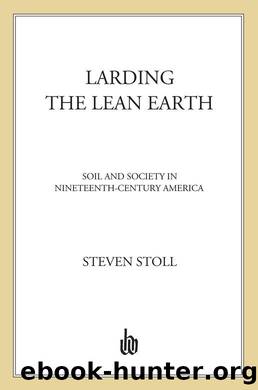Larding the Lean Earth: Soil and Society in Nineteenth-Century America by Stoll Steven

Author:Stoll, Steven [Stoll, Steven]
Language: eng
Format: epub
Publisher: Farrar, Straus and Giroux
Published: 2003-07-03T00:00:00+00:00
The contagion of emigration reached high and low. James Henry Hammondâborn in the Newberry District, a furious defender of southern nationalism and slavery, and governor of South Carolina from 1842 to 1844âfelt the same temptation but held off long enough to attempt one last push on his worn land: âIf I can get 800 or 1000 acres marled [with calcium carbonate to lower the acidity of the soil] ⦠I shall be contented here. Two years will fully test this experiment, and if it fails I have no hope left but emigration.â Hammond claimed that hardly a single one of the young men from his youth remained in the state. He purchased land in Texas but never moved to it, reluctant, according to his biographer, to leave âhis political ventures and personal ties.â147 In 1844 he tried to redirect the efforts of planters, if not toward improvement then at least toward more profitable crops, as a way of keeping them from the territories. Hammond said moreâthat the era of cotton in the uplands of South Carolina was over and that planters would soon be compelled âto abandon its longer cultivation.â Those who refused to listen would have no choice but to leave for where cotton still made a profit. He could only hope that their numbers remained small and expressed confidence that âthere are someâa large majority I trustâwho prefer to link their destiny with the land that gave them birth and struggle on at home through all the changes which time and fate may bring.â148 Hammond struggled on at home and ended up a bystander to the aftermath of emigration.
Many others left for good and never looked back. The collision between land and practice caused an out-migration that left the established planters of South Carolina trembling. Nilesâ Register reported on the erosion of society, describing it like an army falling back. Reported from Charleston, Virginia: âThe tide of emigration through this place is rapid, and we believe, unprecedented. It is believed that not less than 8,000 individuals, since the 1st of September last, have passed on this route. They are principally from the lower part of this state and South Carolina, bound for Indiana, Illinois, and MichiganâThey jog on, careless of the varying climate, and apparently without regret for the friends and the country they leave behind, seeking forests to fell, and a new country to settle.â As the Nullification Crisis came to a head, it caused some white unionists to flee the state, or, according to a writer for the Portland Evening Advertiser in Montgomery, Alabama, âIt would seem as if North and South Carolina were pouring forth their population in swarms. Perhaps I have gone by in the Creek nation over three thousand persons, all emigrating, including Negroes of course. The fires of their encampments made the woods blaze in all directions ⦠. Politics in South Carolina have had much to do in accelerating this emigration.â A correspondent to the Farmersâ Register also blamed the cold
Download
This site does not store any files on its server. We only index and link to content provided by other sites. Please contact the content providers to delete copyright contents if any and email us, we'll remove relevant links or contents immediately.
| Automotive | Engineering |
| Transportation |
Urban Outlaw by Magnus Walker(2949)
Never by Ken Follett(2879)
OPNsense Beginner to Professional by Julio Cesar Bueno de Camargo(2801)
Sapiens and Homo Deus by Yuval Noah Harari(2412)
Machine Learning at Scale with H2O by Gregory Keys | David Whiting(2287)
A Short History of Nearly Everything by Bryson Bill(2135)
Will by Will Smith(2040)
Hooked: A Dark, Contemporary Romance (Never After Series) by Emily McIntire(1956)
Borders by unknow(1785)
Rationality by Steven Pinker(1764)
Holy Bible (NIV) by Zondervan(1715)
Freedom by Sonny Barger(1485)
The One Percenter Encyclopedia by Bill Hayes(1463)
Five Ways to Fall by K.A. Tucker(1395)
Girls Auto Clinic Glove Box Guide by Patrice Banks(1362)
Far and Near by Neil Peart(1355)
The Becoming by Nora Roberts(1330)
Cuba's Car Culture by Tom Cotter(1325)
A Short History of War by Jeremy Black(1299)
